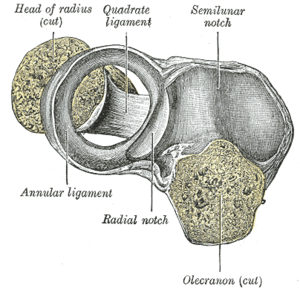Annular Ligament
Attachment:[edit | edit source]
It runs around the radial head form the anterior and the posterior margin o the radial notch, to approximate the radial head to he radial notch and enclose the radial circumference. It encircles 80% o the radial head and unctions to maintain the relationship between the head o the radius and the humerus and ulna. The external surface of the ligament receives attachments from the elbow capsule, the radial collateral ligament, and the supinator muscle.[1]
function:[edit | edit source]
- Holding the proximal radius against the ulna as it fits strongly around the radial head,
- It permits for free rotation of radial head as it's internal surface is lined with cartilage.
clinical significance:[edit | edit source]
A strenuous pull on the forearm through the hand can cause the radial head to slip through the distal end of the annular ligament. Young children are particularly susceptible to this “pulled-elbow” syndrome because of ligamentous laxity, a nonossified radial head, relative reduced strength and slowed reflexes and the increased likelihood of others forcefully pulling on their arms—such as a parent, or even a pet dog . One of the best ways to prevent this dislocation is to explain to parents how a sharp pull on the child’s hand can cause such a dislocation.
References[edit | edit source]
- ↑ Bozkurt M, Acar H, Apaydin N, Leblebicioglu G, Elhan A, Tekdemir İ et al. The Annular Ligament. The American Journal of Sports Medicine. 2005;33(1):114-118.







